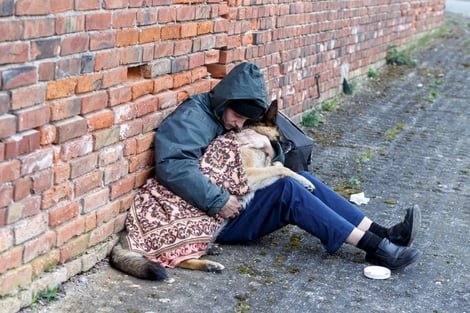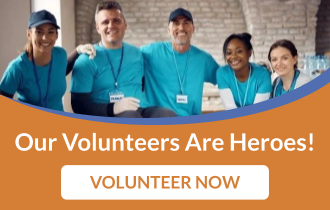Homeless Pets and Access to Veterinary Care

Movement Is Growing to Assist Struggling Pet Parents
When pet parents are struggling financially, large veterinary bills can cause stress and hardship and even contribute to the national crisis in homeless pets. According to the American Society for the Prevention of Cruelty to Animals (ASPCA), 6.5 million pets enter shelters and 1.5 million shelter pets are euthanized every single year.
Access to veterinary care is a social justice issue. People at all socioeconomic levels have pets. Asking people who struggle with their own bills to give up their pets sounds logical, but it doesn’t consider what happens to those animals or what happens to that family when the bond between a pet and their person is broken.
Sometimes desperate owners surrender beloved pets to shelters when they can no longer afford to care for them. Others release animals into “the wild” when they can’t secure shelter. Both options can lead to a scared and confused pet. And due to financial difficulties, some people make the difficult choice to live in unstable or unsafe conditions — outdoors or in vehicles — with their pets because they cannot imagine life without all their family members.
Housing insecurity is prevalent, especially during the pandemic, and low-income pet parents have an especially hard time finding housing during these uncertain times.
People experiencing this type of economic stress know how heartbreaking it can be to make choices about veterinary care when their family is struggling to survive. A number of pets are euthanized because their parents can’t manage an expensive treatment or surgery. Sometimes this is the most humane choice for the pet, even though it can lead to heartbreak for their person and for veterinary staff members who cannot afford to treat every pet in need of lifesaving care.
Many of these scenarios involving homeless pets are preventable if we work together as a society to ensure that all humans and pets get access to food, shelter, and health care.
Tough Times for Pet Parents
Early in the COVID-19 pandemic, an article in the Journal of the American Veterinary Medical Association (AVMA) pointed to increased numbers of people reporting that they couldn’t afford veterinary care — and requesting assistance — due to the economic stresses they were facing.
Reports like that make us worry about pet parents who are already having trouble making ends meet. A 2015 study by the ASPCA found that free or low-cost veterinary care was one of the top needs identified by pet owners earning less than $50,000 a year. Forty-six percent of survey respondents said they gave up a pet because of a health issue, and 26% said they couldn’t afford veterinary care.
That’s why a movement has been expanding to address the needs of low-income pet owners as one strategy to reduce the number of homeless pets.
A National Movement Meets a Growing Need
Collaborative efforts between donors, veterinarians, and nonprofit organizations are helping meet the growing needs of pet parents. Private practice veterinarians often offer some informal discounts for low-income families, but this movement takes the concept further than charity for individuals. “A formal movement advocating access to care for every pet owner, regardless of ability to pay, is a recent development,” writes Anna Campbell in an article in Veterinary Information Network News. Now advocates around the country are creating community-based efforts to address pet homelessness and support the bonds between pets and people.
In 2016, the Access to Veterinary Care Coalition (AVCC) was formed to educate and advocate for access to affordable veterinary care. The group works in partnership with the University of Tennessee College of Social Work, which offers an innovative program in Veterinary Social Work.
The AVCC’s primary goals are
- Developing and promoting methods for providing access to veterinary care for the millions of pets without it
- Responding to policy and regulatory efforts that hinder access to veterinary care
- Improving collaboration between private and nonprofit veterinary service providers and social service providers
- Providing guidance to the veterinary profession on promoting access to vet care for all pet parents
The AVCC conducted a nationwide study, Access to Veterinary Care: Barriers, Current Practices, and Public Policy. That 2018 study demonstrated just how great the need is. Some of the study’s findings were
- In the two years prior to the study’s release, one of four (27.9%) households experienced barriers to veterinary care.
- An estimated 29 million dogs and cats live in families that participate in the Supplemental Nutrition Assistance Program (SNAP; previously known as food stamps).
In the study’s Foreword, Dr. David Satcher, the 16th Surgeon General of the United States, wrote: “Access to veterinary care gives families a reason for hope — a way to keep families together.”
The veterinary social work program created the Program for Pet Health Equity, which creates national collaborations to reduce barriers to veterinary care. With significant help from the nonprofit foundation Maddie’s Fund, Pet Health Equity launched a project called AlignCare™, which allocates funds to participating veterinary clinics. Veterinary social workers refer pet parents in need to the clinics, which provide subsidized care.
If any of this sounds familiar, it’s because One Health Organization’s Veterinary Care Voucher program as a benefit to low-income families with pets does just that.
Solutions for Northeast Ohio
In February 2019, a group convened the Pet Homelessness Regional Summit to brainstorm innovative solutions to pet homelessness in our region. One Health Organization participated and shared information on the Voucher program, which, at the time of this writing, has provided nearly $204,000 in vet care for low-income pet parents in Northeast Ohio since 2014.
The summit began with each participant putting forward a vision for an ideal future where every cat and dog born in Northeast Ohio has a home. The creativity and commitment of the participants were inspiring, and will very likely move the conversation forward to collaborative action.
After everyone shared their ideas, the participants voted on what they called the Key Opportunity Areas, including
- Leading efforts to provide low-cost, free, and accessible veterinary care, including spay/neuter, microchip, and basic health needs
- Forming a Power to the Paw Coalition that would expand upon the participants’ ideas and membership
- Working with local officials on funding and policy changes to change exclusionary and discriminatory laws
- Exploring a time-share location for foster pet groups
Other local area agencies, including animal shelters, are working toward opening full-service veterinary clinics within their facilities. We’re very excited about these initiatives. Even after they open their vet care doors, there will always be a need for more access to vet care, such as through the Veterinary Care Voucher program at One Health Organization. The need is that great.
A Future Where Every Pet Has a Home
Despite the setbacks of the pandemic, we are encouraged by all these efforts to keep families together and provide veterinary care to more families in need. More donors, veterinarians, foundations, and community advocates are recognizing the positive ways animals contribute to our families’ well-being, health, and happiness.
It shows the power of committed organizing and collaborative, creative thinking. And it gives us hope for a future where happy humans live in harmony with healthy pets.

